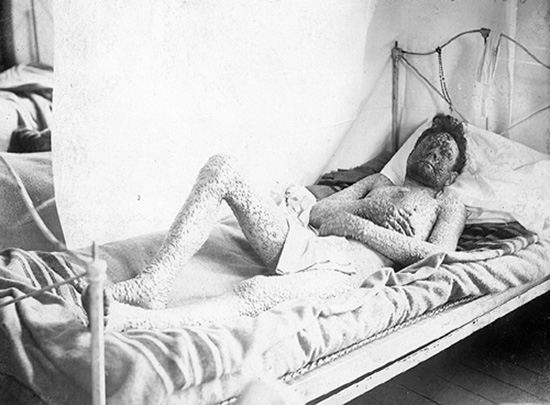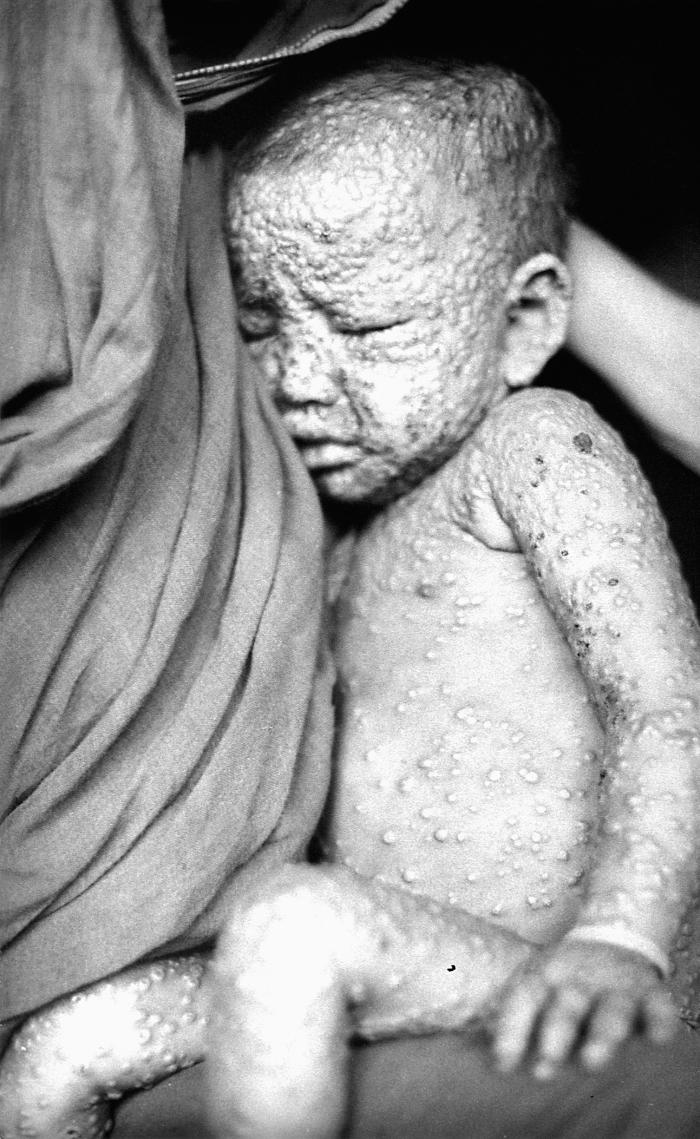| |
Introduction
The disease of smallpox has a long, long history; the tombs of Egyptian pharaohs provide evidence of its existence long before it arrived in the New World. It was endemic in Europe in the sixteenth century, mainly targeting the young, though not always. Because it has such a long history, and because medical descriptions of the symptoms have not changed much over the centuries, historians of medicine who study the history of health and disease look to our current knowledge of smallpox to help them interpret what happened in the past. Historians recognize that diseases can change over time, due to gene mutations, available treatments, and the attitudes of communities toward the disease. Historians also acknowledge that response to a disease is influenced by the "look" of the disease and the way it can affect the body. Current medical knowledge helps historians understand how particular diseases looked in the past.
The two components of the document below allow you to explore our current understanding of smallpox. You will then be alert to similarities and differences in the ways that Aztecs and Spaniards encountered "virgin soil" epidemics. In the sixteenth century, Europeans knew that smallpox was contagious, but they had no understanding of viral etiology. ("Etiology" is the explanation a community gives for a disease. Today we believe that viruses are the cause of many infections; the Aztecs in contrast attributed many illnesses to the displeasure of their gods.)
Question to Consider
-
As you read through the "facts" and examine the photos below, try to imagine what it must have been like for an inhabitant of Tenochtitlán to come down with smallpox, a disease never before encountered within the culture.
Documents
Part A: Smallpox Factsheet
Description of the disease:
Smallpox is a highly contagious viral infection caused by the virus Variola major. The name of the disease refers to its best-known symptom, the small pustules that cover the body of the smallpox victim and the scars from the rash that can leave the victim severely disfigured.
Symptoms and course of the disease:
-
Begins as a high fever, fatigue, a severe headache, and backache.
-
Followed by a rash that appears first in the mouth and throat, and which then spreads to the face, forearms, trunk, and legs.
-
Unlike chicken pox, smallpox sores appear in abundance on the palms of the hands and soles of the feet.
-
Other symptoms include delirium, vomiting, diarrhea, and hemorrhaging both internally and externally.
-
Individual pox become pus-filled sores that crust over by the eighth or ninth day.
-
Pustules can either be separate, discrete sores or run together into a single oozing mass (the more deadly of the two forms).
-
Smallpox victims often have peculiar, offensive odors.
Spread of the disease:
-
The virus has a two-week incubation period.
-
Victims remain contagious from just before the symptoms appear until the last scab drops off, usually around three weeks later.
-
Once symptoms appear, smallpox is highly contagious.
-
Usually spread by saliva droplets.
-
Can also be spread through contact with the corpse of a victim or by contact with clothing or blankets recently contaminated by pus or scabs.
Mortality and immunity:
-
Not everyone who comes in contact with smallpox will develop symptoms.
-
Mortality from smallpox is about 30%.
-
Patients whose pustules merge into a single mass stand at least a 60% chance of dying.
-
Survivors develop immunity to recurring infection.
Status of smallpox today:
-
Prevention of smallpox takes the form of vaccination [Edward Jenner developed the vaccine in 1792. Prior to Jenner's work, inoculation was the only form of protection. Inoculation was developed in Africa or Asia. Unlike a vaccination, inoculation uses a "live" form of the virus to induce a mild case of smallpox, which means that inoculated individuals can spread the smallpox virus as they come down with the mild form of the disease.]
-
Worldwide vaccination program to eradicate smallpox began in 1967.
-
U.S. government stopped the compulsory vaccination program for American children in 1972.
-
Last known case of endemic smallpox was in Bangladesh in 1975.
-
Smallpox declared officially eradicated in 1979.
-
Bioterrorist threats in the twenty-first century revived discussions of vaccination.
Sources:
Adapted from Donald R. Hopkins, Princes and Peasants: Smallpox in History (Chicago: University of Chicago Press, 1983).
"Smallpox Disease Overview" from the Centers for Disease Control and Prevention. http://www.bt.cdc.gov/agent/smallpox/
overview/disease-facts.asp
Part B: Images of Smallpox

(click to enlarge)
Source:
National Museum of Health and Medicine, Armed Forces Institute of Pathology, Washington, D.C., Image NCP 48135.
*** 
(click to enlarge)
Source:
Centers for Disease Control and Prevention, Public Health Images Library (PHIL) id# 131.
***

Source:
Composite of two images from World Health Organization Slideset on Diagnosis of Smallpox, World Health Organization.
***

(click to enlarge)
Source:
Centers for Disease Control and Prevention, Public Health Images Library.
Next >>>
<<< Return to Evidence
|